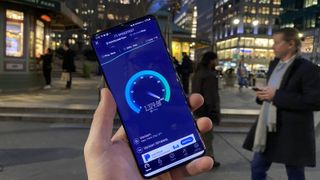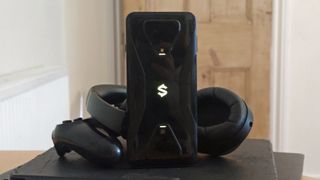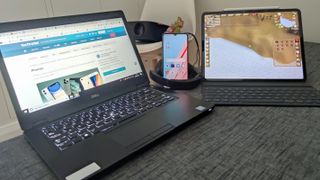Can a 5G phone give my whole flat high-speed internet? I found out
Surprising results

When 5G started rolling out, I was one of the many, many people who didn’t understand why we needed even faster data – and even after testing many 5G phones, and experiencing their snappy connection speeds, I still wasn’t sold.
That's changed, though, after an extensive test to see how powerful a hotspot a 5G phone could really be – with a result that I bet will be handy for plenty of other people too in the long run.
Discussions around 5G mostly focus around video calling on the go, mobile gaming and quick movie and TV show downloads. But when I found myself without home internet access for a month, I was forced to explore the wonders of 5G hot-spotting. Here’s how that happened.
Losing my connection
I moved to a new flat recently, into a place that wasn’t rigged for high-speed internet (it had been refurbished and partly rebuilt). So I was faced with the awkward prospect of going without home internet – something anyone in today's online world should find equally horrifying.
It seems broadband engineers only operate on a full moon or when the planets align, because the earliest we could get our new place rigged for Wi-Fi was 22 days – over 3 whole weeks – after we moved in.
The prospect was sickening – me, a young millennial, go without Wi-Fi for three weeks? How would I browse social media? How would I stream Warzone with my colleagues? How would I video call my friends? And, somewhat importantly (in case my editor's reading), how would I continue to do all my work?

Sure, some of those tasks could be done on data, but not all of them, and not without burning through the stuff faster than I burn my morning bagels. I realized I’d have to turn into a super-hoarder of data, only turning it on at regular and sporadic intervals, or just move home or to another flat for three weeks.
Get daily insight, inspiration and deals in your inbox
Get the hottest deals available in your inbox plus news, reviews, opinion, analysis and more from the TechRadar team.
But as I was packing away my belongings in my old flat, and cataloguing the myriad phones I’ve been sent to test, I saw plenty of 5G phones, and a thought began to form in my mind. It was a thought of a test, a trial by fire for 5G capability, a chance for it to win me over. Could I use a 5G phone as a hotspot to provide high-speed internet access for my new flat, for me and a flatmate to work and relax on our various devices? Well, as I write for TechRadar, it was basically my job to find out.
5G or not to be
The phone I opted to become my new ersatz router was the Xiaomi Black Shark 3, a gaming-focused phone I reviewed about a month prior.
My reasons were twofold. Firstly, gaming phones typically have more antennae to improve connectivity when gaming, and I reasoned that could improve the connectivity for our flat.
Secondly, one of the Black Shark 3’s peripherals caught my eye: this was the FunCooler, used to keep the device cool during long periods of gaming. Since phones running as hotspots can get pretty, well, hot, I figured this might be useful to keep the ‘router’ stable.

- We've got loads of 5G phone deals here
I didn’t plug both the Black Shark 3 and FunCooler into the wall, as they both use USB-C, and I don’t have enough converters to spare. I plugged both into a portable 20,000mAh power bank, which itself powered up via micro USB.
This way, my ‘router’ only took up one plug, not two, and I also figured since micro USB powers up quite slowly, only a small amount of power would trickle into the phone – enough to keep it fully charged, but not to ruin the battery with it being constantly fast-charging. Again, this is something I put no critical thinking or scientific reasoning into, it just seemed like a good idea.
Finally, I needed the holy grail: the 5G SIM card. I went with Vodafone, given I use it for my personal SIM, and it meant I could head over to the new flat before moving there, run a speed test, and make sure high-speed internet was definitely available at the place. (Clearly it was, or this article would stop right here.)
I visited three of the company’s stores in London – neither Google Maps, nor the company’s website, had very accurate information on which shops were open – and ended up queuing for an hour at the Oxford Street shop, stuffed into a face mask.
I left the shop with the perfect SIM, though – 5G-compatible, unlimited data, no speed cap, and on a thirty-day plan, all for £37 (which felt pretty reasonable, given what I was planning to do with it).
Getting home, the first thing I did was slot the SIM into the phone. Now the real testing was due to start.
Fully connected

I generally use three gadgets at any one time: whatever phone I’m testing, my iPad Pro, and my work laptop. During a workday I can be using all three for various tasks, and frequently I’ll have to connect various other devices too. I’ve also got a PS4 I tried to use over 5G, too.
My flatmate has a desktop computer and a smartphone, and at times we also had guests over (with social distancing in place), so generally, it’s safe to say we had five or six devices connected to the router at any given time.
Stop reading this article for a moment, and take a guess at what kind of internet speeds we were looking at on each device. Maybe head over to Google’s internet speed test to see what kind of connection you have on whatever device you’re using right now.
Bear in mind that 5G in my area on Vodafone sometimes goes as high as 200mbps – while writing this article it only went up to 20mbps, and 5G is consistently inconsistent at the best of times, but let’s talk about top speeds right now.
On his desktop computer, my flatmate reported a top speed of 50mbps – that’s an impressively fast speed, given it’s actually twice as fast as our Wi-Fi was in our old flat, and also when five other devices were also seeing similar internet speeds.
That’s the fastest speed we’ve seen, and generally, when I run an internet test it’ll see results in the 20s and 30s. There was some variation based on device, as laptops, tablets, phones and other devices of various ages and make all have different antennae and receivers, but it was always around that level.
So what could we do on it? Working was easy enough, so was streaming music and scrolling through social media, so we turned our testing up a notch.

I found early on that I could play Oldschool Runescape Mobile without any noticeable lag, and my flatmate was playing multiplayer Europa Universalis with no issues. When he tested League of Legends, his ping was 40 – not great, but equally not terrible for a PC hotspotting off a phone.
A big holdout was my PS4, which seemingly wasn’t too happy about connecting to the hotspot, and I only got 3.9mbps on it. This was enough to download games on – albeit skin-crawling slowly – but I decided neither Warzone nor Fall Guys warranted such mistreatment as being made to run on this speed.
The only real issue, though, was video chatting – every time I joined a meeting over Google Meet, after a few minutes it’d drop out, and I could only carry on listening if I turned off Wi-Fi on my phone to only use personal 5G.
That’s only one function that didn’t work very well though, and given everything else I tried worked fine (and more than fine, in some cases), I was ready to be forgiving.
At the time of writing this article I’ve been using my home-made router for a week now, and I’m constantly forgetting it’s not a real router. For every 10 things I do on the internet, 9 of them work just as they did before, and I’m finding my standard speeds are faster than they were on Wi-Fi in my old flat.
In fact, this solution is cheaper too – I’m currently paying £37 per month for that 5G plan, whereas my old broadband plan was £50 per month (which my new one also is, but that’s at least for faster speeds, apparently).
I’ve got two more weeks of living this 5G life before engineers come around and turn my flat into a standard old Wi-Fi den, and while I’m keen for that to happen – it’d be nice to play online games on my PS4 again – I’ve been very surprised by the results of this 5G test. The speeds were much higher than I expected, and I’ve been able to do so much more than I thought.
So if you’re a frequent hotspotter – maybe you like bringing your devices out and about to work, or have a family who always likes to stay connected on the go – 5G might have a pretty big impact for you.

Tom Bedford was deputy phones editor on TechRadar until late 2022, having worked his way up from staff writer. Though he specialized in phones and tablets, he also took on other tech like electric scooters, smartwatches, fitness, mobile gaming and more. He is based in London, UK and now works for the entertainment site What To Watch.
He graduated in American Literature and Creative Writing from the University of East Anglia. Prior to working on TechRadar, he freelanced in tech, gaming and entertainment, and also spent many years working as a mixologist. He also currently works in film as a screenwriter, director and producer.
